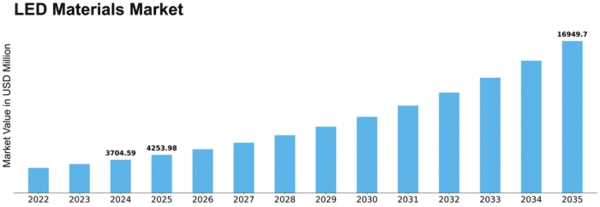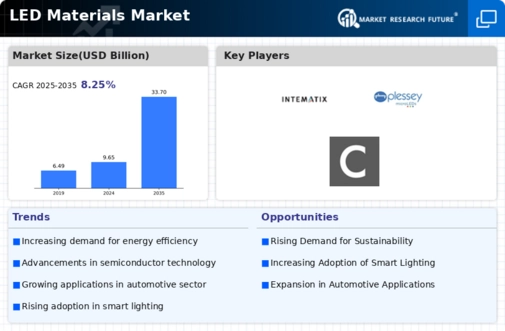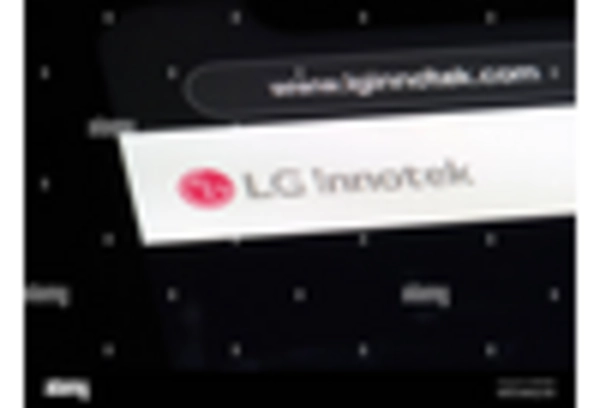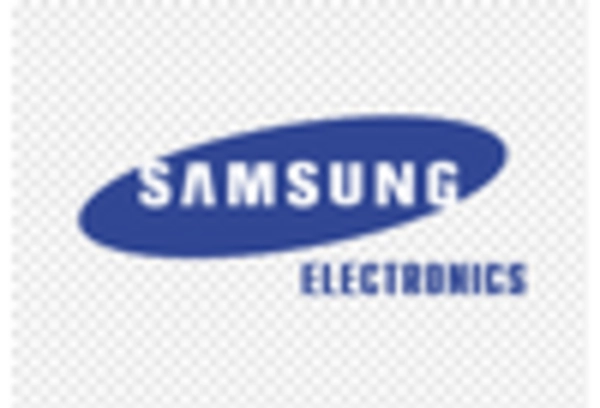-
Executive Summary
-
Market Introduction
-
Definition 18
-
The Scope of the Study 18
-
List of Assumptions
-
Limitations 18
-
Market Structure 19
-
Research Methodology
-
Research Process 21
-
Primary Research
-
Secondary Research 23
-
Market Size Estimation 23
-
Forecast Model 24
-
Market Dynamics
-
Introduction
-
Drivers 27
- Rising Demand for Energy-Efficient Lights
- Expanding Automotive Industry 27
- Increasing Use
- Drivers Impact
-
in Digital Advertising and Consumer Electronics 27
-
Analysis 28
-
Restraints 28
- Environmental Threats 28
-
Restraints Impact Analysis 29
-
Opportunities 29
- Increasing
- Li-Fi Technology 29
- Introduction of New LED Materials 29
- Prevalence
-
Use of LEDs across Industries 29
-
Trends 29
-
of Quantum Dot as Down Conversion Material in LEDs 30
-
Market Factor Analysis
-
Supply Chain Analysis 32
- Raw
- LED Materials Manufacturers 32
- End-Use Industry 33
-
Material Suppliers 32
-
Distribution Channel 33
-
Porter’s
- Threat of New Entrants 34
- Threat
- Threat of Substitutes 34
- Bargaining
- Bargaining Power of Buyers 34
-
Five Forces Model 33
-
of Rivalry 34
-
Power of Suppliers 34
-
Global LED Materials Market, by Type
-
Introduction 36
- Sapphire 38
- Silicon 39
- Others 40
-
Wafers 37
-
Silicon Carbide 39
-
Substrates/Semiconductors
- Gallium Arsenide 42
- Gallium Nitride 42
- Indium Gallium Nitride 43
- Aluminium
-
Gallium Phosphide 43
-
Gallium Arsenide 44
-
Phosphor 44
-
Epitaxy Material 45
-
Others 45
-
Global LED Materials Market, by Application
-
Introduction 47
-
General Lighting 48
- Residential Lighting
- I&I Lighting 50
- Outdoor Lighting 50
-
Others 51
-
Consumer Electronics 51
- Handheld Devices
- Televisions 53
- Backlight 54
- Monitors
- Others 55
-
Automotive Exterior Lighting 55
-
Displays & Billboards 56
-
Automotive Interior Lighting 56
-
Specialty Lighting 57
-
Healthcare 57
-
Others 58
-
Global LED Materials Market, by Region
-
Introduction 60
- U.S. 65
- Canada 66
- Germany 70
- France 71
- U.K.
- Russia 73
- Spain 74
- Italy 75
- Rest of Europe 77
-
North America 62
-
Europe 67
-
Poland 76
-
Asia-Pacific 78
- India 82
- Japan 83
- Australia
- ASEAN 85
- South Korea 86
-
China 81
-
& New Zealand 84
-
Rest of Asia-Pacific 87
-
-
Latin America 88
- Mexico 92
- Argentina 93
-
Brazil 91
-
Rest of Latin America 94
-
Middle East & Africa 95
- Israel 99
- North Africa 100
- Rest of the Middle East & Africa 102
-
Turkey 98
-
G.C.C. 101
-
Competitive Landscape
-
Introduction 104
-
Market Strategy
-
Analysis 104
-
Key Developments of Market Players 105
-
Company Profiles
-
AkzoNobel N.V. 109
- Company Overview
- Financial Overview 109
- Products Offerings
- Key Developments 110
- Key Strategies 110
- Company Overview 111
- Financial Overview
- Products Offered 111
- Key Developments 112
-
Intematix 111
-
Key Strategy 112
-
OSRAM Opto Semiconductors GmbH (OSRAM) 113
- Financial Overview 113
- Products
- Key Developments 114
- Key Strategy
-
Company Overview 113
-
Offered 113
-
-
Nichia Corporation 115
- Company
- Financial Overview 115
- Products Offered
- Key Developments 115
- Key Strategy 115
- Company Overview 116
- Financial
- Products Offered 117
- Key Developments
- Key Strategy 117
-
Overview 115
-
Epistar Corporation 116
-
Overview 116
-
EpiGan 118
- 1.7.2 Financial Overview 118
- Key Developments 118
- Key
-
Company Overview 118
-
Products Offered 118
-
Strategy 118
-
Plessey 119
- Company Overview 119
- Products Offered 119
- Key
- Key Strategy 119
-
Financial Overview 119
-
Developments 119
-
Sumitomo Electric
- Company Overview 120
- Financial
- Products Offerings 120
- Key Developments
- Key Strategies 121
-
Industries, Ltd 120
-
Overview 120
-
Cree, Inc. 122
- Financial Overview 122
- Key Developments 123
-
Company Overview 122
-
Products Offerings 122
-
Key Strategies 123
-
MACOM 124
- Company Overview
- Financial Overview 124
- Products Offered
- Key Developments 125
- Key Strategy 125
- Company Overview 126
- Products Offered 126
- Key Strategy 127
-
UBE INDUSTRIES, LTD 126
-
Financial Overview 126
-
Key Developments 127
-
DOWA Electronics
- Company Overview
- Financial Overview 128
- Products Offerings
- Key Developments 128
- Key Strategy 128
- Company Overview 129
- Products Offered 129
- Key Strategy 130
-
Materials Co., Ltd (DOWA Materials Co., Ltd) 128
-
II-VI Incorporated 129
-
Financial Overview 129
-
Key Developments 130
-
Conclusion
-
Key Findings 132
-
List of Tables
-
TABLE
-
MARKET SYNOPSIS 16
-
GLOBAL LED MATERIALS MARKET VALUE, BY TYPE,
-
(2018–2024) (USD MILLION) 36
-
GLOBAL WAFERS MARKET FOR LED
-
MATERIALS MARKET, BY TYPE, (2018–2024) (USD MILLION) 37
-
TABLE 4
-
GLOBAL WAFERS MARKET FOR LED MATERIALS MARKET, BY REGION, (2018–2024) (USD
-
MILLION) 38
-
GLOBAL SAPPHIRE MARKET FOR LED MATERIALS MARKET, BY
-
REGION, (2018–2024) (USD MILLION) 38
-
GLOBAL SILICON MARKET
-
FOR LED MATERIALS MARKET, BY REGION, (2018–2024) (USD MILLION) 39
-
TABLE
-
GLOBAL SILICON CARBIDE MARKET FOR LED MATERIALS MARKET, BY REGION, (2018–2024)
-
(USD MILLION) 39
-
GLOBAL OTHERS MARKET FOR LED MATERIALS MARKET,
-
BY REGION, (2018–2024) (USD MILLION) 40
-
GLOBAL SUBSTRATES/SEMICONDUCTORS
-
MARKET FOR LED MATERIALS MARKET, BY TYPE, (2018–2024) (USD MILLION) 41
-
TABLE
-
GLOBAL SUBSTRATES/SEMICONDUCTORS MARKET FOR LED MATERIALS MARKET, BY REGION,
-
(2018–2024) (USD MILLION) 41
-
GLOBAL GALLIUM ARSENIDE MARKET
-
FOR LED MATERIALS MARKET, BY REGION, (2018–2024) (USD MILLION) 42
-
TABLE
-
GLOBAL GALLIUM NITRIDE MARKET FOR LED MATERIALS MARKET, BY REGION, (2018–2024)
-
(USD MILLION) 42
-
GLOBAL GALLIUM PHOSPHIDE MARKET FOR LED MATERIALS
-
MARKET, BY REGION, (2018–2024) (USD MILLION) 43
-
GLOBAL
-
INDIUM GALLIUM NITRIDE MARKET FOR LED MATERIALS MARKET, BY REGION, (2018–2024)
-
(USD MILLION) 43
-
GLOBAL ALUMINIUM GALLIUM ARSENIDE MARKET FOR
-
LED MATERIALS MARKET, BY REGION, (2018–2024) (USD MILLION) 44
-
TABLE
-
GLOBAL PHOSPHOR MARKET FOR LED MATERIALS MARKET, BY REGION, (2018–2024)
-
(USD MILLION) 44
-
GLOBAL EPITAXY MATERIAL MARKET FOR LED MATERIALS
-
MARKET, BY REGION, (2018–2024) (USD MILLION) 45
-
GLOBAL
-
OTHER MARKET FOR LED MATERIALS MARKET, BY REGION, (2018–2024) (USD MILLION)
-
GLOBAL LED MATERIALS MARKET VALUE, BY APPLICATION, (2018–2024)
-
(USD MILLION) 47
-
GLOBAL GENERAL LIGHTING MARKET FOR LED MATERIALS
-
MARKET, BY APPLICATION, (2018–2024) (USD MILLION) 48
-
GLOBAL
-
GENERAL LIGHTING MARKET FOR LED MATERIALS MARKET, BY REGION, (2018–2024) (USD
-
MILLION) 49
-
GLOBAL RESIDENTIAL LIGHTING MARKET FOR LED MATERIALS
-
MARKET, BY REGION, (2018–2024) (USD MILLION) 49
-
GLOBAL
-
I&I LIGHTING MARKET FOR LED MATERIALS MARKET, BY REGION, (2018–2024) (USD
-
MILLION) 50
-
GLOBAL OUTDOOR LIGHTING MARKET FOR LED MATERIALS
-
MARKET, BY REGION, (2018–2024) (USD MILLION) 50
-
GLOBAL
-
OTHERS MARKET FOR LED MATERIALS MARKET, BY REGION, (2018–2024) (USD MILLION)
-
GLOBAL CONSUMER ELECTRONICS MARKET FOR LED MATERIALS MARKET,
-
BY APPLICATION, (2018–2024) (USD MILLION) 52
-
GLOBAL CONSUMER
-
ELECTRONICS MARKET FOR LED MATERIALS MARKET, BY REGION, (2018–2024) (USD MILLION)
-
GLOBAL HANDHELD DEVICES MARKET FOR LED MATERIALS MARKET, BY
-
REGION, (2018–2024) (USD MILLION) 53
-
GLOBAL TELEVISION
-
MARKET FOR LED MATERIALS MARKET, BY REGION, (2018–2024) (USD MILLION) 53
-
TABLE
-
GLOBAL BACKLIGHT MARKET FOR LED MATERIALS MARKET, BY REGION, (2018–2024)
-
(USD MILLION) 54
-
GLOBAL MONITORS MARKET FOR LED MATERIALS MARKET,
-
BY REGION, (2018–2024) (USD MILLION) 54
-
GLOBAL OTHERS MARKET
-
FOR LED MATERIALS MARKET, BY REGION, (2018–2024) (USD MILLION) 55
-
TABLE
-
GLOBAL AUTOMOTIVE EXTERIOR LIGHTING MARKET FOR LED MATERIALS MARKET, BY REGION,
-
(2018–2024) (USD MILLION) 55
-
GLOBAL DISPLAYS & BILLBOARDS
-
MARKET FOR LED MATERIALS MARKET, BY REGION, (2018–2024) (USD MILLION) 56
-
TABLE
-
GLOBAL AUTOMOTIVE INTERIOR LIGHTING MARKET FOR LED MATERIALS MARKET, BY REGION,
-
(2018–2024) (USD MILLION) 56
-
GLOBAL SPECIALTY LIGHTING
-
MARKET FOR LED MATERIALS MARKET, BY REGION, (2018–2024) (USD MILLION) 57
-
TABLE
-
GLOBAL HEALTHCARE MARKET FOR LED MATERIALS MARKET, BY REGION, (2018–2024)
-
(USD MILLION) 58
-
GLOBAL OTHERS MARKET FOR LED MATERIALS MARKET,
-
BY REGION, (2018–2024) (USD MILLION) 58
-
GLOBAL LED MATERIALS
-
MARKET, BY REGION, (2018–2024) (USD MILLION) 60
-
GLOBAL
-
LED MATERIALS MARKET, BY TYPE, (2018–2024) (USD MILLION) 61
-
TABLE
-
GLOBAL LED MATERIALS MARKET, BY APPLICATION, (2018–2024) (USD MILLION)
-
NORTH AMERICA: LED MATERIALS MARKET, BY REGION, (2018–2024)
-
(USD MILLION) 62
-
NORTH AMERICA: LED MATERIALS MARKET, BY TYPE,
-
(2018–2024) (USD MILLION) 63
-
NORTH AMERICA: LED MATERIALS
-
MARKET, BY APPLICATION, (2018–2024) (USD MILLION) 64
-
U.S.:
-
LED MATERIALS MARKET, BY TYPE, (2018–2024) (USD MILLION) 65
-
TABLE
-
U.S.: LED MATERIALS MARKET, BY APPLICATION, (2018–2024) (USD MILLION) 65
-
TABLE
-
CANADA: LED MATERIALS MARKET, BY TYPE, (2018–2024) (USD MILLION) 66
-
TABLE
-
CANADA: LED MATERIALS MARKET, BY APPLICATION, (2018–2024) (USD MILLION)
-
EUROPE: LED MATERIALS MARKET, BY REGION, (2018–2024)
-
(USD MILLION) 67
-
EUROPE: LED MATERIALS MARKET, BY TYPE, (2018–2024)
-
(USD MILLION) 68
-
EUROPE: LED MATERIALS MARKET, BY APPLICATION,
-
(2018–2024) (USD MILLION) 69
-
GERMANY: LED MATERIALS MARKET,
-
BY TYPE, (2018–2024) (USD MILLION) 70
-
GERMANY: LED MATERIALS
-
MARKET, BY APPLICATION, (2018–2024) (USD MILLION) 70
-
FRANCE:
-
LED MATERIALS MARKET, BY TYPE, (2018–2024) (USD MILLION) 71
-
TABLE
-
FRANCE: LED MATERIALS MARKET, BY APPLICATION, (2018–2024) (USD MILLION)
-
U.K.: LED MATERIALS MARKET, BY TYPE, (2018–2024) (USD
-
MILLION) 72
-
U.K.: LED MATERIALS MARKET, BY APPLICATION, (2018–2024)
-
(USD MILLION) 72
-
RUSSIA: LED MATERIALS MARKET, BY TYPE, (2018–2024)
-
(USD MILLION) 73
-
RUSSIA: LED MATERIALS MARKET, BY APPLICATION,
-
(2018–2024) (USD MILLION) 73
-
SPAIN: LED MATERIALS MARKET,
-
BY TYPE, (2018–2024) (USD MILLION) 74
-
SPAIN: LED MATERIALS
-
MARKET, BY APPLICATION, (2018–2024) (USD MILLION) 74
-
ITALY:
-
LED MATERIALS MARKET, BY TYPE, (2018–2024) (USD MILLION) 75
-
TABLE
-
ITALY: LED MATERIALS MARKET, BY APPLICATION, (2018–2024) (USD MILLION)
-
POLAND: LED MATERIALS MARKET, BY TYPE, (2018–2024) (USD
-
MILLION) 76
-
POLAND: LED MATERIALS MARKET, BY APPLICATION, (2018–2024)
-
(USD MILLION) 76
-
REST OF EUROPE: LED MATERIALS MARKET, BY TYPE,
-
(2018–2024) (USD MILLION) 77
-
REST OF EUROPE: LED MATERIALS
-
MARKET, BY APPLICATION, (2018–2024) (USD MILLION) 77
-
ASIA-PACIFIC:
-
LED MATERIALS MARKET SHARE, BY COUNTRY, 2020 (% SHARE) 78
-
ASIA-PACIFIC:
-
LED MATERIALS MARKET, BY REGION, (2018–2024) (USD MILLION) 78
-
TABLE
-
ASIA-PACIFIC: LED MATERIALS MARKET, BY TYPE, (2018–2024) (USD MILLION)
-
ASIA-PACIFIC: LED MATERIALS MARKET, BY APPLICATION, (2018–2024)
-
(USD MILLION) 80
-
CHINA: LED MATERIALS MARKET, BY TYPE, (2018–2024)
-
(USD MILLION) 81
-
CHINA: LED MATERIALS MARKET, BY APPLICATION,
-
(2018–2024) (USD MILLION) 81
-
INDIA: LED MATERIALS MARKET,
-
BY TYPE, (2018–2024) (USD MILLION) 82
-
INDIA: LED MATERIALS
-
MARKET, BY APPLICATION, (2018–2024) (USD MILLION) 82
-
JAPAN:
-
LED MATERIALS MARKET, BY TYPE, (2018–2024) (USD MILLION) 83
-
TABLE
-
JAPAN: LED MATERIALS MARKET, BY APPLICATION, (2018–2024) (USD MILLION)
-
AUSTRALIA & NEW ZEALAND: LED MATERIALS MARKET, BY TYPE,
-
(2018–2024) (USD MILLION) 84
-
AUSTRALIA & NEW ZEALAND:
-
LED MATERIALS MARKET, BY APPLICATION, (2018–2024) (USD MILLION) 84
-
TABLE
-
ASEAN: LED MATERIALS MARKET, BY TYPE, (2018–2024) (USD MILLION) 85
-
TABLE
-
ASEAN: LED MATERIALS MARKET, BY APPLICATION, (2018–2024) (USD MILLION)
-
SOUTH KOREA: LED MATERIALS MARKET, BY TYPE, (2018–2024)
-
(USD MILLION) 86
-
SOUTH KOREA: LED MATERIALS MARKET, BY APPLICATION,
-
(2018–2024) (USD MILLION) 86
-
REST OF ASIA-PACIFIC: LED
-
MATERIALS MARKET, BY TYPE, (2018–2024) (USD MILLION) 87
-
TABLE 85
-
REST OF ASIA-PACIFIC: LED MATERIALS MARKET, BY APPLICATION, (2018–2024) (USD
-
MILLION) 87
-
LATIN AMERICA: LED MATERIALS MARKET SHARE, BY COUNTRY,
-
LATIN AMERICA: LED MATERIALS MARKET, BY REGION,
-
(2018–2024) (USD MILLION) 88
-
LATIN AMERICA: LED MATERIALS
-
MARKET, BY TYPE, (2018–2024) (USD MILLION) 89
-
LATIN AMERICA:
-
LED MATERIALS MARKET, BY APPLICATION, (2018–2024) (USD MILLION) 90
-
TABLE
-
BRAZIL: LED MATERIALS MARKET, BY TYPE, (2018–2024) (USD MILLION) 91
-
TABLE
-
BRAZIL: LED MATERIALS MARKET, BY APPLICATION, (2018–2024) (USD MILLION)
-
MEXICO: LED MATERIALS MARKET, BY TYPE, (2018–2024) (USD
-
MILLION) 92
-
MEXICO: LED MATERIALS MARKET, BY APPLICATION, (2018–2024)
-
(USD MILLION) 92
-
ARGENTINA: LED MATERIALS MARKET, BY TYPE, (2018–2024)
-
(USD MILLION) 93
-
ARGENTINA: LED MATERIALS MARKET, BY APPLICATION,
-
(2018–2024) (USD MILLION) 93
-
REST OF LATIN AMERICA: LED
-
MATERIALS MARKET, BY TYPE, (2018–2024) (USD MILLION) 94
-
TABLE 97
-
REST OF LATIN AMERICA: LED MATERIALS MARKET, BY APPLICATION, (2018–2024) (USD
-
MILLION) 94
-
MIDDLE EAST & AFRICA: LED MATERIALS MARKET, BY
-
REGION, (2018–2024) (USD MILLION) 95
-
MIDDLE EAST &
-
AFRICA: LED MATERIALS MARKET, BY TYPE, (2018–2024) (USD MILLION) 96
-
TABLE
-
MIDDLE EAST & AFRICA: LED MATERIALS MARKET, BY APPLICATION, (2018–2024)
-
(USD MILLION) 97
-
TURKEY: LED MATERIALS MARKET, BY TYPE, (2018–2024)
-
(USD MILLION) 98
-
TURKEY: LED MATERIALS MARKET, BY APPLICATION,
-
(2018–2024) (USD MILLION) 98
-
ISRAEL: LED MATERIALS MARKET,
-
BY TYPE, (2018–2024) (USD MILLION) 99
-
ISRAEL: LED MATERIALS
-
MARKET, BY APPLICATION, (2018–2024) (USD MILLION) 99
-
NORTH
-
AFRICA: LED MATERIALS MARKET, BY TYPE, (2018–2024) (USD MILLION) 100
-
TABLE
-
NORTH AFRICA: LED MATERIALS MARKET, BY APPLICATION, (2018–2024) (USD MILLION)
-
G.C.C.: LED MATERIALS MARKET, BY TYPE, (2018–2024)
-
(USD MILLION) 101
-
G.C.C.: LED MATERIALS MARKET, BY APPLICATION,
-
(2018–2024) (USD MILLION) 101
-
REST OF THE MIDDLE EAST
-
& AFRICA: LED MATERIALS MARKET, BY TYPE, (2018–2024) (USD MILLION) 102
-
TABLE
-
REST OF THE MIDDLE EAST & AFRICA: LED MATERIALS MARKET, BY APPLICATION,
-
(2018–2024) (USD MILLION) 102
-
KEY DEVELOPMENTS 105
-
List of Figures
-
GLOBAL LED MATERIALS MARKET: MARKET STRUCTURE
-
RESEARCH PROCESS OF MRFR 21
-
TOP-DOWN &
-
BOTTOM-UP APPROACH 24
-
DROC ANALYSIS OF GLOBAL LED MATERIALS MARKET
-
DRIVERS IMPACT ANALYSIS: LED MATERIALS MARKET 28
-
FIGURE
-
RESTRAINTS IMPACT ANALYSIS: LED MATERIALS MARKET 29
-
SUPPLY
-
CHAIN: LED MATERIALS MARKET 32
-
PORTER'S FIVE FORCES ANALYSIS
-
OF THE GLOBAL LED MATERIALS MARKET 33
-
GLOBAL LED MATERIALS MARKET
-
SHARE, BY TYPE, 2020-2027(USD MILLION) 36
-
GLOBAL WAFERS MARKET
-
FOR LED MATERIALS MARKET, BY TYPE, 2020-2027(USD MILLION) 37
-
FIGURE 11
-
GLOBAL SUBSTRATES/SEMICONDUCTORS MARKET FOR LED MATERIALS MARKET, BY TYPE, 2018–2024,
-
(USD MILLION) 40
-
GLOBAL LED MATERIALS MARKET SHARE, BY APPLICATION,
-
GLOBAL GENERAL LIGHTING MARKET VALUE,
-
BY APPLICATION, (2018–2024) (USD MILLION) 48
-
GLOBAL CONSUMER
-
ELECTRONICS MARKET FOR LED MATERIALS MARKET, BY REGION, 2020-2027(USD MILLION) 51
-
FIGURE
-
GLOBAL LED MATERIALS MARKET SHARE, BY REGION, 2020 (%) 60
-
FIGURE 16
-
NORTH AMERICA: LED MATERIALS MARKET SHARE, BY COUNTRY, 2020 (%) 62
-
FIGURE
-
NORTH AMERICA: LED MATERIALS MARKET, BY TYPE, 2020-2027(USD MILLION) 63
-
FIGURE
-
NORTH AMERICA: LED MATERIALS MARKET, BY APPLICATION, 2020-2027(USD MILLION) 64
-
FIGURE
-
EUROPE: LED MATERIALS MARKET SHARE, BY COUNTRY, 2020 (%) 67
-
FIGURE
-
EUROPE: LED MATERIALS MARKET, BY TYPE, 2020-2027(USD MILLION) 68
-
FIGURE
-
EUROPE: LED MATERIALS MARKET, BY APPLICATION, 2020-2027(USD MILLION) 69
-
FIGURE
-
ASIA-PACIFIC: LED MATERIALS MARKET, BY TYPE, 2020-2027(USD MILLION) 79
-
FIGURE
-
ASIA-PACIFIC: LED MATERIALS MARKET, BY APPLICATION, 2020-2027(USD MILLION) 80
-
FIGURE
-
LATIN AMERICA: LED MATERIALS MARKET, BY TYPE, 2020-2027(USD MILLION) 89
-
FIGURE
-
LATIN AMERICA: LED MATERIALS MARKET, BY APPLICATION, 2020-2027(USD MILLION) 90
-
FIGURE
-
MIDDLE EAST & AFRICA: LED MATERIALS MARKET SHARE, BY COUNTRY, 2020 (%) 95
-
FIGURE
-
MIDDLE EAST & AFRICA: LED MATERIALS MARKET, BY TYPE, 2020-2027(USD MILLION)
-
MIDDLE EAST & AFRICA: LED MATERIALS MARKET, BY APPLICATION,
-


















Leave a Comment